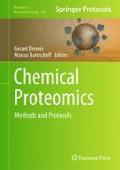Abstract
Chemical proteomics offers a unique approach for target identification of small molecule inhibitors directly from cell extracts, thus enabling characterization of target proteins under close to physiological conditions. Here, we describe a competition binding procedure that is based on affinity enrichment of potential target proteins on a probe matrix in the presence of increasing amounts of free test compound in solution. Reduced binding of target proteins to the probe matrix as a function of test compound concentration can be measured and thus, enables calculation of IC50 values. The method employs quantitative mass spectrometry using isobaric mass tags which enables determination of potency for a large number of target proteins in a single analysis.
Access this chapter
Tax calculation will be finalised at checkout
Purchases are for personal use only
References
Scholten, A., Poh, M. K., van Veen, T. A., van Breukelen, B., Vos, M. A., and Heck, A. J. (2006) Analysis of the cGMP/cAMP interactome using a chemical proteomics approach in mammalian heart tissue validates sphingosine kinase type 1-interacting protein as a genuine and highly abundant AKAP, J Proteome Res 5, 1435–1447.
Shiyama, T., Furuya, M., Yamazaki, A., Terada, T., and Tanaka, A. (2004) Design and synthesis of novel hydrophilic spacers for the reduction of nonspecific binding proteins on affinity resins, Bioorg Med Chem 12, 2831–2841.
Brehmer, D., Godl, K., Zech, B., Wissing, J., and Daub, H. (2004) Proteome-wide identification of cellular targets affected by bisindolylmaleimide-type protein kinase C inhibitors, Mol Cell Proteomics 3, 490–500.
Brehmer, D., Greff, Z., Godl, K., Blencke, S., Kurtenbach, A., Weber, M., Muller, S., Klebl, B., Cotten, M., Keri, G., Wissing, J., and Daub, H. (2005) Cellular targets of gefitinib, Cancer Res 65, 379–382.
Godl, K., Gruss, O. J., Eickhoff, J., Wissing, J., Blencke, S., Weber, M., Degen, H., Brehmer, D., Orfi, L., Horvath, Z., Keri, G., Muller, S., Cotten, M., Ullrich, A., and Daub, H. (2005) Proteomic characterization of the angiogenesis inhibitor SU6668 reveals multiple impacts on cellular kinase signaling, Cancer Res 65, 6919–6926.
Remsing Rix, L. L., Rix, U., Colinge, J., Hantschel, O., Bennett, K. L., Stranzl, T., Muller, A., Baumgartner, C., Valent, P., Augustin, M., Till, J. H., and Superti-Furga, G. (2009) Global target profile of the kinase inhibitor bosutinib in primary chronic myeloid leukemia cells, Leukemia 23, 477–485.
Rix, U., Hantschel, O., Durnberger, G., Remsing Rix, L. L., Planyavsky, M., Fernbach, N. V., Kaupe, I., Bennett, K. L., Valent, P., Colinge, J., Kocher, T., and Superti-Furga, G. (2007) Chemical proteomic profiles of the BCR-ABL inhibitors imatinib, nilotinib, and dasatinib reveal novel kinase and nonkinase targets, Blood 110, 4055–4063.
Bantscheff, M., Eberhard, D., Abraham, Y., Bastuck, S., Boesche, M., Hobson, S., Mathieson, T., Perrin, J., Raida, M., Rau, C., Reader, V., Sweetman, G., Bauer, A., Bouwmeester, T., Hopf, C., Kruse, U., Neubauer, G., Ramsden, N., Rick, J., Kuster, B., and Drewes, G. (2007) Quantitative chemical proteomics reveals mechanisms of action of clinical ABL kinase inhibitors, Nat Biotechnol 25, 1035–1044.
Sharma, K., Weber, C., Bairlein, M., Greff, Z., Keri, G., Cox, J., Olsen, J. V., and Daub, H. (2009) Proteomics strategy for quantitative protein interaction profiling in cell extracts, Nat Methods 6, 741–744.
Bantscheff, M., Boesche, M., Eberhard, D., Matthieson, T., Sweetman, G., and Kuster, B. (2008) Robust and sensitive iTRAQ quantification on an LTQ Orbitrap mass spectrometer, Mol Cell Proteomics 7, 1702–1713.
Griffin, T. J., Xie, H., Bandhakavi, S., Popko, J., Mohan, A., Carlis, J. V., and Higgins, L. (2007) iTRAQ reagent-based quantitative proteomic analysis on a linear ion trap mass spectrometer, J Proteome Res 6, 4200–4209.
Olsen, J. V., de Godoy, L. M., Li, G., Macek, B., Mortensen, P., Pesch, R., Makarov, A., Lange, O., Horning, S., and Mann, M. (2005) Parts per million mass accuracy on an Orbitrap mass spectrometer via lock mass injection into a C-trap, Mol Cell Proteomics 4, 2010–2021.
Kocher, T., Pichler, P., Schutzbier, M., Stingl, C., Kaul, A., Teucher, N., Hasenfuss, G., Penninger, J. M., and Mechtler, K. (2009) High precision quantitative proteomics using iTRAQ on an LTQ Orbitrap: a new mass spectrometric method combining the benefits of all, J Proteome Res 8, 4743–4752.
Savitski, M. M., Fischer, F., Mathieson, T., Sweetman, G., Lang, M., and Bantscheff, M. (2010) Targeted data acquisition for improved reproducibility and robustness of proteomic mass spectrometry assays, J Am Soc Mass Spectrom 21, 1668–1679.
Eng, J. K., McCormack, A. L., and Yates Iii, J. R. (1994) An approach to correlate tandem mass spectral data of peptides with amino acid sequences in a protein database, J Am Soc Mass Spectrom 5, 976–989.
Perkins, D. N., Pappin, D. J., Creasy, D. M., and Cottrell, J. S. (1999) Probability-based protein identification by searching sequence databases using mass spectrometry data, Electrophoresis 20, 3551–3567.
Acknowledgments
We would like to thank Frank Fischer, Sonja Ghidelli-Disse, and Thilo Werner for contributions to the development of the protocol, Frank Weisbrodt for help with the figures and Gerard Drewes for discussions and advice.
Author information
Authors and Affiliations
Corresponding author
Editor information
Editors and Affiliations
Rights and permissions
Copyright information
© 2012 Springer Science+Business Media, LLC
About this protocol
Cite this protocol
Hopf, C., Eberhard, D., Boesche, M., Bastuck, S., Dümpelfeld, B., Bantscheff, M. (2012). Determination of Kinase Inhibitor Potencies in Cell Extracts by Competition Binding Assays and Isobaric Mass Tags. In: Drewes, G., Bantscheff, M. (eds) Chemical Proteomics. Methods in Molecular Biology, vol 803. Humana Press, Totowa, NJ. https://doi.org/10.1007/978-1-61779-364-6_10
Download citation
DOI: https://doi.org/10.1007/978-1-61779-364-6_10
Published:
Publisher Name: Humana Press, Totowa, NJ
Print ISBN: 978-1-61779-363-9
Online ISBN: 978-1-61779-364-6
eBook Packages: Springer Protocols

